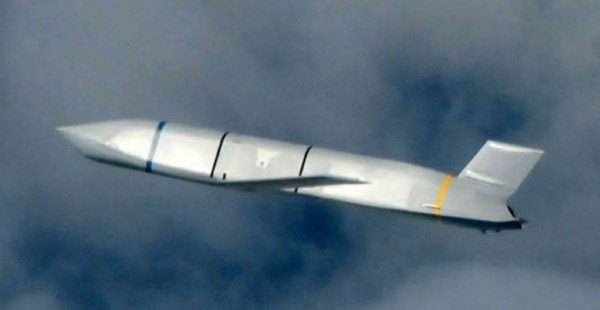LRASM, First US Missile with Artificial Intelligence, to be Deployed by 2018
| Arthur Dominic Villasanta | | Jun 25, 2016 12:38 AM EDT |
(Photo : Lockheed Martin) LRASM in flight
An anti-ship cruise missile (ASCM) developed by the U.S. Defense Advanced Research Projects Agency (DARPA) that "thinks" thanks to its onboard artificial intelligence (AI) will arm U.S. Navy warships and strike aircraft beginning 2019 and U.S. Air Force combat aircraft in 2018.
Like Us on Facebook
The Long Range Anti-Ship Missile (LRASM) can find a warship target on its own by using its onboard AI to locate a specific warship from among a fleet of enemy warships. A multi-mode seeker guided by the AI ensures the correct warship is hit in a specific area to maximize the probability of sinking the target.
The AI enables autonomous targeting by using on-board targeting systems to independently acquire a target without the need for prior precision intelligence, GPS or data-links. These capabilities allow positive target identification and the precision engagement of moving warships in an enemy fleet heavily defended by surface-to-air missiles (SAMs) and electronic countermeasures. The missile is designed with counter-countermeasures to evade active defense systems on enemy ships.
Built by Lockheed Martin, LRASM will be an effective counter to the capabilities of the People's Liberation Army Navy (PLAN) that relies on long-range anti-ship missiles (ASMs) and SAMs for its offensive and defensive power. Its warhead is a 450 kg blast-fragmentation penetrator.
LRASM, which carries the identifier AGM-158C, can be launched at a target PLAN warship from as far away as 370 kilometers. That places the launching U.S. attack aircraft well out of the range of the Chinese HHQ-9 SAM defending many of the PLAN's modern warships. HHQ-9, the PLAN's most modern SAM, has a slant range of 200 km.
More tellingly, multiple LRASMs can share data to coordinate an attack as a swarm. Enhancing the glide weapon's survivability is that it doesn't emit any signals that can be detected by the enemy. This advantage combined with a low-radar cross section airframe and a low infrared signature reduces the chance of detection.
LRASM is compatible with the Mk 41 Vertical Launch System on many US Navy warships. It will also arm F/A-18E/F Super Hornets, which will be able to carry two missiles, and the F-35C Joint Strike Fighter (two LRASMs).
A U.S. Air Force B-1 can carry up to 24 LRASMs. The B-2, B-52, F-15E Strike Eagle and F-16 will also be armed with the AI missile.
DARPA and the Office of Naval Research collaborated on the LRASM program, which successfully launched its first prototype in August 2013. DARPA designed the free-flight transition test demonstration to verify the missile's flight characteristics and assess subsystem and sensor performance.
TagsLong Range Anti-Ship Missile, LRASM, Defense Advanced Research Projects Agency, Artificial Intelligence, U.S. Navy, People's Liberation Army Navy
©2015 Chinatopix All rights reserved. Do not reproduce without permission
EDITOR'S PICKS
-

Did the Trump administration just announce plans for a trade war with ‘hostile’ China and Russia?
-

US Senate passes Taiwan travel bill slammed by China
-

As Yan Sihong’s family grieves, here are other Chinese students who went missing abroad. Some have never been found
-

Beijing blasts Western critics who ‘smear China’ with the term sharp power
-

China Envoy Seeks to Defuse Tensions With U.S. as a Trade War Brews
-

Singapore's Deputy PM Provides Bitcoin Vote of Confidence Amid China's Blanket Bans
-

China warns investors over risks in overseas virtual currency trading
-

Chinese government most trustworthy: survey
-

Kashima Antlers On Course For Back-To-Back Titles
MOST POPULAR
LATEST NEWS
Zhou Yongkang: China's Former Security Chief Sentenced to Life in Prison

China's former Chief of the Ministry of Public Security, Zhou Yongkang, has been given a life sentence after he was found guilty of abusing his office, bribery and deliberately ... Full Article
TRENDING STORY

China Pork Prices Expected to Stabilize As The Supplies Recover

Elephone P9000 Smartphone is now on Sale on Amazon India

There's a Big Chance Cliffhangers Won't Still Be Resolved When Grey's Anatomy Season 13 Returns

Supreme Court Ruled on Samsung vs Apple Dispute for Patent Infringement

Microsoft Surface Pro 5 Rumors and Release Date: What is the Latest?












